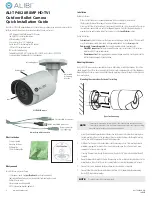
61
ķ
high-capacity power source with a low self-discharge rate.
Remove the batteries from the flash unit if it is not going to be used
for an extended period of time.
2.2.2 Replacing batteries (Fig. 1)
The batteries are exhausted if the recycling time (elapsing from the triggering
of a full-power flash, e.g. in the M mode, to the moment the flash ready indi-
cator lights up again) exceeds 60 seconds.
• Turn off the flash unit by its main switch.
• Slide the battery compartment cover in the direction of the arrow and fold
open.
• Insert the batteries lengthwise in conformity with the indicated battery sym-
bols and close the battery compartment cover.
When loading batteries ensure correct polarity, as indicated by the
symbols in the battery compartment. Mixed up battery poles may
destroy the flash unit!
Replace all batteries at a time and make sure that the batteries are of
the same brand and type and have the same capacity!
Exhausted batteries must not be thrown in the dustbin! Help protect
the environment and dispose of exhausted batteries at the appro-
priate collecting points.
2.3 Switching the flash unit on and off
The flash unit is switched on with the main switch on top of the battery com-
partment cover. In the upper „ON“ position, the flash unit is on.
To turn off the flash unit push the main switch down to its bottom position.
If your flash unit is not going to be used for an extended period of
time, we recommend to switch it off with the main switch and to
remove the power sources (batteries).
2.4 Auto-OFF for the flash unit (Fig. 2)
To save battery power and prevent inadvertent battery discharge, the flash
unit is factory-set to automatically switch-over to standby mode (Auto-OFF),
while flash readiness and the LC display are simultaneously switched off,
☞
☞
☞
approx. 3 minutes after:
• Switch-on
• Firing a flash
• Actuating the shutter release
• Switching off the camera’s exposure metering system.
After automatic switch-off the last-used settings are retained and instantly
available when the flash unit is switched on again. The flash unit is reacti-
vated merely by depressing the „Mode“ or „Zoom“ key or by touching the
shutter release (wake-up function).
The flash unit should always be turned off by the main switch if it is
not going to be used for an extended period!
The Auto-OFF function can be deactivated whenever required:
Turning off the Auto-OFF function
• Turn on the flash unit by its main switch.
• Continue depressing the key combination „Select“ (= „Mode“ key + „Zoom“
key) until the LC display indicates „3m“ (= 3 minutes).
• Continue depressing the „Zoom“ key until „OFF“ flashes on the LC display.
• The setting becomes immediately effective. The LC display returns to normal
display after approx. 5 sec.
Turning on the Auto-OFF function
• Turn on the flash unit by its main switch.
• Continue depressing the key combination „Select“ (= „Mode“ key + „Zoom“
key) until the LC display indicates „3m“ (= 3 minutes).
• Continue depressing the „Zoom“ key until „ON“ flashes on the LC display.
• The setting becomes immediately effective. The LC display returns to its nor-
mal state after approx. 5 sec.
3. Programmed Auto Flash Mode (Full Auto Mode)
In Programmed Auto Flash Mode the camera controls the aperture and shut-
ter speed, as well as the flash unit, automatically so that optimal results are
☞






































